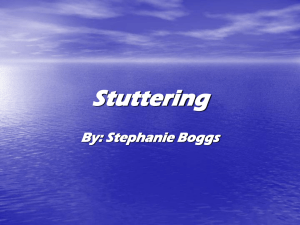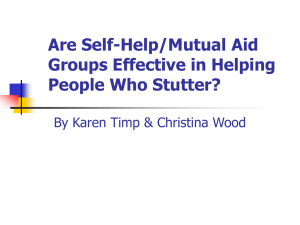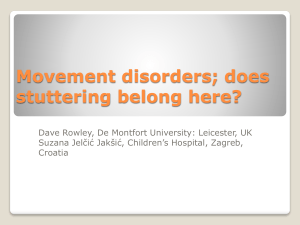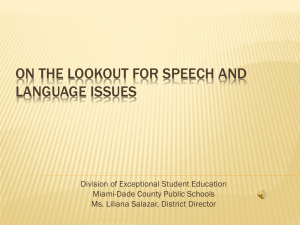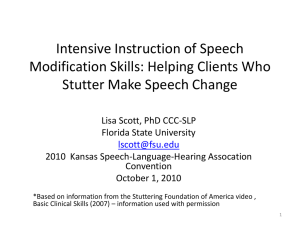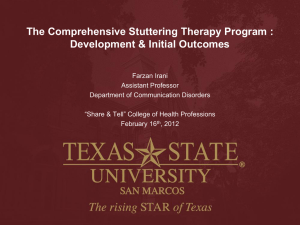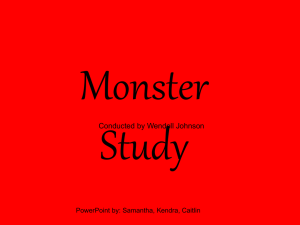Hannan & Reichardt Differential Diagnosis & Treatment for
advertisement
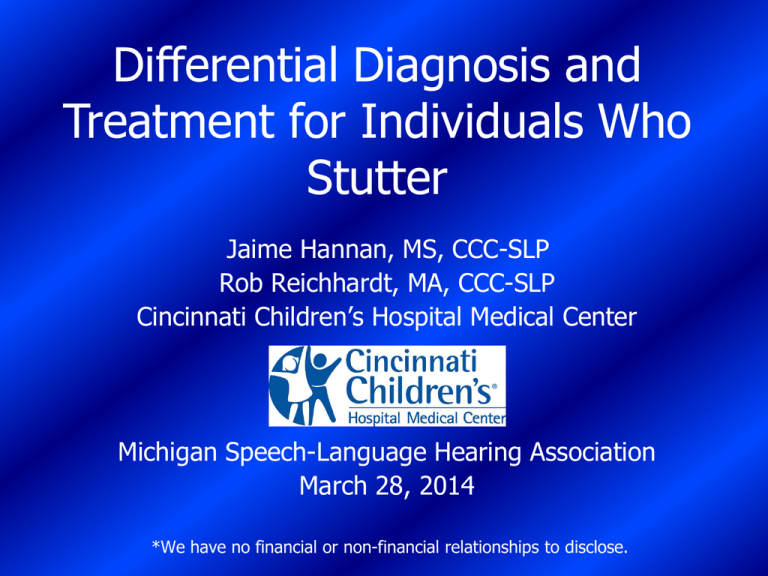
Differential Diagnosis and Treatment for Individuals Who Stutter Jaime Hannan, MS, CCC-SLP Rob Reichhardt, MA, CCC-SLP Cincinnati Children’s Hospital Medical Center Michigan Speech-Language Hearing Association March 28, 2014 *We have no financial or non-financial relationships to disclose. Overview • • • • What is Stuttering? The Basic Principles Evaluation Treatment – Preschool – School-age – Adolescents Stuttering • Stuttering defined: – Van Riper: Stuttering occurs when the forward flow of speech is interrupted by a motorically disrupted sound, syllable, or word or the speaker's reactions thereto. – Stuttering Foundation of America: Stuttering is a communication disorder in which the flow of speech is broken by repetitions (li-li-like this), prolongations (lllllike this), or abnormal stoppages (no sound) of sounds and syllables. There may also be facial and body movements associated with the effort to speak.” Stuttering • National Stuttering Association: People who stutter often experience physical tension and struggle in their speech muscles, as well as embarrassment, anxiety, and fear about speaking. Together, these symptoms can make it very difficult for people who stutter to say what they want to say, and to communicate effectively with others. Stuttering • Core Behaviors – – – – * Part-word repetitions (c-cat) Monosyllabic whole-word repetitions (on-on) Prolongations (lllllike) Blocks (inaudible; audible) May have multi-component disfluencies • Secondary Behaviors: – Facial grimace, poor eye contact, arm and leg movements, variations in rate and pitch, use of interjections • Typical Disfluencies (not representative of stuttering) – – – – Repetition of multi-syllabic words (because-because) Repetition of phrases (I want-I want) Revisions Interjections (um, uh) • *Consider - are interjections being used to avoid stuttering moment? Incidence/Prevalence • Incidence – As many as 15% of children will have a period of disfluency (Bloodstein, 1995) – 5% will have a period of disfluency lasting longer than 6 months (Andrews et al, 1983) • Prevalence – 1% of US population; over 3 million people (Bloodstein, 1995; Andrews et al, 1983). ***Other sources have similar findings Onset Patterns and Recovery • Onset for most between ages 2-5 • Children who begin stuttering before age 3;6 are more likely to outgrow stuttering. • Children with onset before age 3 have better chance of recovery within 6 months (regardless of severity) (Yairi & Ambrose, 1992, 1999, 2005) • Recovery Rates • 74% (Yairi & Ambrose, 1999) – 84 children – 4 years post onset • 71% (Mansson, 2000) – 51 children – Within 2 years of onset Key Risk Factors • We can never “guarantee” that a child will recover from stuttering; however, several risk factors exist that enable us to predict persistence vs. recovery (Yairi & Ambrose, 1992, 1999, 2005). – – – – Time since onset Age of onset Pattern since onset Family history • ½ of all children who stutter have a family member who stutters; less risk if the family member outgrew stuttering as a child. – Gender – Other speech and language deficits http://www.stutteringhelp.org/risk-factors Theories About Stuttering • The next several slides detail a historical perspective on the causes of stuttering. • Some theories have since been abandoned, while others continue to contribute to current clinical work with individuals who stutter. Theories About Stuttering • Constitutional Factors – Disorder of brain organization • Cerebral dominance (Geswind & Galaburda, 1985; Webster, 1993a) – Disorder of timing • Timing functions for speech are less efficient; vulnerable to interference during moments of increased emotion (Van Riper, 1982; Kent, 1984) – Disorder as reduced capacity for internal modeling • Have difficulty making sensory-to-motor and motorto-sensory transformations; predisposition (Neilson & Neilson, 1987; Max et al, 2004) Theories, cont. – Language production deficit • Stuttering often increases as load on language functions is heaviest (e.g., conversation vs. single words) (Bloodstein, 2002) • Covert repair hypothesis – stuttering results as correcting the phonological errors detected in the phonetic plan before they are spoken (Kolk & Postma, 1997) • Dyssynchrony of two components of language production; left (linguistic) and right (paralinguistic) hemispheres (Perkins, Kent, & Curlee, 1991) – Additionally, person must experience time pressure and a feeling of “loss of control.” Theories, cont. – Physiological tremor • Some stutters are characterized by rapid, rhythmic, oscillatory neural input to the muscles of speech so that they are contracting in a tremorlike way (Smith, 1989) Theories, cont. • Developmental/Environmental Factors – Diagnosogenic theory • Stuttering evolves from normal fluency breaks to which others mislabel as “stuttering” (Johnson et al, 1942) – Communicative failure and anticipatory struggle • Stuttering emerges from a child’s experiences of frustration and failure when trying to talk (Bloodstein, 1987, 1997) – Demands and capacities • Disfluencies emerge when a child’s capacities for fluency are not equal to speech performance demands (Starkweather, 1987) Theories, cont. • What do we know today – No exact “cause” for stuttering. – Two-stage etiological model (Guitar, 2006) • Primary stuttering - results due to some dyssynchrony at some level of the speech and language development process. • Secondary stuttering - result of a separate constitutional factor - a reactive temperament that triggers a defense response. Characteristics of PWS • We will explore each of the following characteristics on the next few slides. – Neuropsychological – Linguistic – Phonological/Motor – Temperament – Sensory Neurophysiological and Linguistic Factors • Brain Differences • • • • Greater activation of right hemisphere (for adults) Inhibited activity in auditory cortex bilaterally Novel activation patterns Chang et al. 2008 (subjects age 8-12), reduced left side gray matter in speech area; no increase in right side activation (reinforced over time); reduced left side white matter integrity in motor regions of face and larynx • Linguistic Factors • Mixed findings • “The most recent findings dispel previous reports that children who begin stuttering have, as a group, lower language skills. On the contrary, there are indications that they are well within the norms or above. Advanced language skills appear to be even more of a risk factor for children whose stuttering persists” (Yairi & Ambrose, 2005). Phonological and Motor Skills • Greater difficulty with phonological processing • Difficulty using proprioceptive feedback to control and coordinate motor tasks • Reduced coordination for articulation/oral motor movements • Reduced coordination in finger tapping and hand clapping Temperament • A temperamental bias refers to a distinctive profile of feelings and behaviors that originate in the child’s biology and appear early in development (Rothbart, 1989). • CWS showed higher emotional reactivity, lower emotional regulation, and lower attention regulation (McDevitt & Carey, 1978). • Characteristics of highly sensitive children • Have greater physical tension, especially in laryngeal area in response to new or threatening situations (Kagan & Snidman, 1991) • Are more sensitive, reactive to external stimuli, and less adaptive to change (Anderson et al, 2003). • PWS (preschool) have higher levels of gross motor behaviors and impulsivity; decreased attention, focus, and inhibitory control (Embrechts & Ebben, 2000). Temperament, cont. • Anxiety • As stuttering persists, increased likelihood that individual will react with increased anxiety. • If persists into adolescence, increased Trait (long-term) and State (momentary) anxiety. • As many as 60% of adults who stutter present with clinically significant levels of anxiety. Sensory • Sensory processing is an overarching term that refers to the method the nervous system uses to receive, organize, and understand sensory input (Miller & Lane, 2000). – In PWS: Differences exist in the neurological networks that process sensory information (Ludlow & Loucks, 2003) – The Auditory Cortex is underactive during speech and stuttering in PWS, indicating a tendency for deficient auditory sensory feedback (Yairi & Seery, 2011) – Supporting the sensory system in therapy! Learned Behavior • Operant Conditioning • Negative Reinforcement: behavior removes an unpleasant experience; secondary behaviors - this is why they grow. • Classical Conditioning • Associations over time; phone ringing=anxiety. • Avoidance Conditioning • A behavior that prevents an unpleasant experience: interjections, word changing, not participating in class - these are reinforced because you AVOID the negative experience. Stuttering • People who stutter may be classified as covert or overt. – Overt • Stutter openly – Covert • Try to hide stuttering • Change words • Avoid situations The Iceberg Analogy of Stuttering (Joseph Sheehan, 1970) The Basic Principles • What are they? – Developed by Hugo Gregory (1968, 1975, 2003) – A way of “clinical thinking” that assists SLPs in the ongoing application of evidence based practices. • Assists SLPs with varying levels of experience explore, create, and implement success-driven solutions. • Applies to various locations and types of service through appropriate interpretation. • Recognizes the unique temperament and experiences of each individual, and focuses on positive relationship between relevant parties engaged in process. – Continuous process; principles are simultaneously interactive. • Other research contributed to framework of this process. – General scientific logic set (Tilly, 2008) • Analyze problem, determine plan, and evaluate outcomes – Various similar thinking processes, Heartland Method (Reschly-Ysseldyke, 1995) • Framework for defining a problem; conversational discrepancies – Framework similar to (DIR): Developmental, Individual Difference, Relationship-Based Model • Intervention based on child and family’s unique needs Basic Principles • Level 1 – Initial referral, diagnostic planning and evaluation processes; diagnosing, and developing goals and objectives • Level 2 – Executing treatment objectives and monitoring progress in a consistent, ongoing manner • Goals for therapy – Identify discrepancies, determine objectives, plan outcomes What are the Basic Principles? • Differential evaluation – differential treatment – Addresses the complexities of a problem, considering both subject and environmental variables in an ongoing manner. • Relationship – Addresses the manner of interaction between all individuals collaborating to assess and, if necessary, treat the presenting problem. – Starts from the first moment you meet child. – Respect/listen to child’s opinions and ideas. – Shapes what will be done in therapy. Components of an Evaluation • Case history – Medical history/Development history • Milestones: gross motor, fine motor, speech/language, feeding, sensory, behavioral, academic performance, past therapy – Fluency history • Is there a family history of stuttering? • At what age did your child start stuttering (try to pinpoint to a specific month)? • Has the stuttering behavior increased/decreased/remained the same since onset? • Describe your child’s stuttering (e.g., primary/secondary behaviors). • Do you think that your child is aware of his/her stuttering? Evaluation, cont. – Does your child’s stuttering change in certain situations? Around certain people? – What do you do when your child stutters? – Describe your child’s personality in a few words. – Describe your family dynamic (siblings at home; competition for talk time, etc.). • Fluency Samples – Play/conversation sample with caregiver (especially in preschoolage children) – Conversation sample with clinician – Oral reading sample – Pressure situations • Stuttering Analysis – – – – Stuttering Severity Instrument SDA (Systematic Disfluency Analysis) (Gregory) Illinois Clinician Stuttering Severity Scale (Yairi) Real-time/online sample Evaluation, cont. • Attitudinal Measures – Preschool-Age Clients • KiddyCAT • Informal measures (pseudo-stuttering) – School-Age/Adolescent Clients • CAT (Communication Attitudes Test) • A19 • OASES (Overall Assessment of the Speaker’s Experiences of Stuttering; different versions for different ages) • Informal measures (pencil and paper exercises; Chmela and Reardon) Evaluation, cont. • Formal/informal testing of: speech skills; language skills; voice; oral motor structures; pragmatic skills; behavior; attention; sensory skills • Discuss findings/recommendations – Therapy – Referrals – Considerations for schools Evaluation, cont. • REMEMBER: The most important aspect of an evaluation is developing a solid picture of the whole child. – Think CALMS model • Cognitive, Affective, Linguistic, Motor and Social Assessment (Healey et al, 2004) Let’s Review… • Differential evaluation – differential treatment – Addresses the complexities of a problem, considering both subject and environmental variables in an ongoing manner. • Relationship – Addresses the manner of interaction between all individuals collaborating to assess and, if necessary, treat the presenting problem. – Starts from the first moment you meet child. – Respect/listen to child’s opinions and ideas. – Shapes what will be done in therapy. Back to the Basic Principles • Counter conditioning, deconditioning, desensitization – Results in more productive behavior, thoughts, and feelings. • Modeling – The most powerful and efficient teaching procedure; is essential. – Needs to be done in a variety of contexts (e.g. location, audience, listener reaction). – Both clinician and caregivers can provide model. Basic Principles • Guided practice – Involves rehearsal of desired changes along hierarchies of difficulty. – Varying levels – Why? How? • Reinforcement – Administered in a positive manner; provides consequences for behavioral change. – Be specific - remember your target. – Spontaneous reinforcement – be a great observer. • Self-monitoring, self-reinforcement – Develops the client’s ability to assess more adaptive behaviors and perceptions. – Self cueing, visual reinforcement, family support Basic Principles • Generalization – Results in learned behaviors occurring in similar situations or in longer responses. – Continual check-in on client’s motivations and goals. – Client vs. caregiver goal. • Transfer – Is supported by systematic guided practice while manipulating meaningful variable. – Client ownership. • Gradual dismissal, follow through, and maintenance – Involves planned review and support to aid in preventing regression. – “The door is always open” – changes in communication pressures and dynamics. Basic Principles • Consideration and integration of motor, social-emotional, sensory, and cognitive factors – Assists with planning and facilitating relevant and functional treatment, ongoing problems solving, and maintenance of progress. Treatment • Now that we’ve talked about evaluation and using the Basic Principles – let’s look at some possible treatment activities for our preschool, school-age, and adolescent clients. Treatment - Preschoolers • Parental involvement • Indirect Therapy – Fluency-enhancing strategies – Turn-taking – Listening • 5 Ps – – – – – Pausing Phrasing Pointing out Praising Paraphrasing • Lidcombe Program • Easy Relaxed Approach - Smooth Movements (ERA-SM) • Bunny/Turtle Speech Treatment - School-Age • Fluency Shaping – speaking fluently/speech restructuring – – – – Modifying rate (pausing and phrasing) Easy onsets Continuous phonation Easy Relaxed Approach – Smooth Movements • Stuttering Modification – stuttering fluently – Identifying stuttering; catching moments of stuttering; modifying moments of stuttering – Desensitization to moments of stuttering – Post-stutter (cancelation), during-stutter (pull-out) and pre-stutter (preparatory set) modifications • Combination of both types Treatment - School-Age Cont. • Attitudes – Explore feelings/fears about stuttering – Informal tools (pencil/paper tasks) • Speaking Situations/Fears/Hierarchy • Operant programs – Lidcombe – ELU – GILCU • Parental involvement Treatment - Adolescents • Many of the treatment approaches mentioned previously for school-aged clients are used for adolescents. Adolescents: Special Considerations • Already formed notions about therapy • What do they want? • Change speech? • Change how they feel about stuttering? • Parental involvement? • What place does stuttering occupy in their lives • Interactive writing – Clinician initiates conversation on paper – Continue on “paper” • Set parameters • They are involved in choosing goals • Decision to have parents observe Adolescents: Special Considerations • 6 types of teen reactions when faced with stressful situations, but have not yet integrated their identity with societal demands/expectation (Elkind, 1998) 1. 2. 3. 4. 5. 6. Anxious: worrying and not “doing” Conforming: doing what other expect instead of what the teen wants Self-punishing: negative self-talk, rejecting opportunities, limiting of self Obsessively competitive: gauging own performance against others, putting others down, have to be the best Angry: acting out verbally or physically, defiance Fearful: avoiding, experiencing intense physical reactions Adolescents: Special Considerations • A Few Life Skills for Coping with Stress (Schmitz & Hipp, 1995) – Recognizing stress and understanding its physical and emotional impact – Differentiating coping from stress management – Engaging in physical activity – Learning methods that lead to relaxation – Developing assertiveness – Building supportive relationships – Engaging in life planning – Using positive self-talk Cognitive Behavioral Therapy • Developed from the work of Bandura, Ellis, Beck, Adler, Meichenbaum, and others. • Explores the relationship between the Cognitive, Affective and Behavioral components of stuttering; helps the patient to gain a clearer understanding of their experiences. • Helps provide clarity to a complex experience for patient. • Helps to objectify a patient’s experience and reactions to stuttering. • A great way to measure a cognitive shift/progress toward being a more effective communicator. “Acceptance and Commitment Therapy” (Hayes, Strosahl, & Wilson, 1999) • Form of CBA treatment • ACT has been used for individuals who have survived trauma (Follette & Pistorello, 2007) • When people survive trauma, they often try to hide their pain or hide from it (avoidance) • Can living with stuttering be a traumatic experience? • Steps to acceptance and moving forward • Awareness to coping strategies/emotion response/thoughts • Develop compassion/acceptance for self • Psychological flexibility » Mindfulness » “Two sides of the coin can be true” » Rational mind (thinking) » Emotional mind (feeling) » Wise mind (interaction of both) Treatment Pointers • Exploration of stuttering • Understand their physical behavior: what are they doing to interfere with forward flowing speech • Cognitive Behavioral Analysis • Desensitization (patient/parent) • The feared “S” word • Education • Advertising • Guided Practice • • • • Vary degrees of modeling Understanding the WHY and HOW; Changing behavior Client-lead hierarchy Transfer activities/Parent support • Affective Communication • Think big picture! • Exploring pragmatics of language (eye contact, contributions to a discussion) Treatment Pointers, Cont. • Reinforcement: Keep it specific • Be descriptive in your observations (appropriate for age) • Lead client to reflect on own success • Positive behavioral changes • • • • Stuttering in a different/easier way (tight-loose) Using an approach that promotes forward flowing speech Client specific!! Real-life situations • An atmosphere where it’s okay to share feelings • Don’t minimize, validate Group Treatment • Advantages • • • • • • Opportunity to work on maintaining changes Combat isolation Open discussion of stuttering in safe environment Monitor transfer of skills in social setting Sense of community/support Learn through observing the success of others • Group Leadership Skills • Active listening • Reflecting • Summarizing • Facilitating • Questioning • Linking • Supporting • Terminating **Not a full list** (Corey, 2008) Communicative Competence: Become an Powerful Communicator • Assertive – Willingness to communicate with others. • Confident – Appropriate eye contact and posture when meeting and greeting new individuals. • Effective – Manner of communication: verbalizing in complete sentences; ability to initiate onset of phonation and smooth movements into and between sounds, and between words; phrasing; rate of information flow; social language skills, etc. • “Conversational Box” Determining Goals • Conversational discrepancies – Difference between environmental (or personal) expectations and what an individual does – Create “Talking Pie” to help determine discrepancies – Think specifics – what?, where?, with whom? – Consider what is most important to the child! Open Discussion • Why do clients stop coming to therapy? – Let’s discuss. Helpful Resources • Stuttering Foundation – http://www.stutteringhelp.org/ • National Stuttering Association – http://www.nsastutter.org/ • Stuttering Home Page – http://www.mnsu.edu/comdis/kuster/stutter.html Helpful Resources • Fluency Team at Cincinnati Children’s Hospital Medical Center – Jaime Hannan, MS, CCC-SLP • jaime.hannan@cchmc.org – Robert Reichhardt, MA, CCC-SLP • robert.reichhardt@cchmc.org • Board Recognized Fluency Specialists – Look up for your area: • http://stutteringspecialists.org/ References Ambrose, N. and Yairi, E. (1999). Normative disfluency data for early childhood stuttering. Journal of Speech, Language, and Hearing Research, 42, 895-909. Anderson, J., Pellowski, M., Conture, E., and Kelly, E. (2003). Temperamental characteristics of young children who stutter. Journal of Speech, Language, and Hearing Research, 46:1221-1233. Andrews, G., Craig, A., Feyer, A.M., Hoddinott, S., Howie, P.M., and Neilson, M.D. (1983). Stuttering: A review of research findings and theories circa 1982. Journal of Speech and Hearing Disorders, 48:226-246. Bloodstein, O. (1987). A Handbook on Stuttering (ed 4). Chicago: National Easter Seal Society. Bloodstein, O. (1995). A Handbook on Stuttering (ed 5). San Diego: Singular. Bloodstein, O. (1997). Stuttering as an anticipatory struggle reaction. In R.F. Curlee and G.M. Siegel (Eds), The Nature and Treatment of Stuttering: New Directions (ed 2). Boston: Allyn & Bacon, pp 169-181. Bloodstein, O. (2002). Early stuttering as a type of language difficulty. Journal of Fluency Disorders, 27:163-167. Chang, S., et al., (2008). Brain anatomy differences in childhood stuttering. Neuroimage, 39(3), 1333-44. Corey, G. (2008). Theory and practice of group counseling (ed 8). Belmont, CA: Brooks/Cole, Cengage Learning. Elkind, D. (1998). All grown up and no place to go (Revised Ed.) Cambridge, MA: Perseus Books. Embrechts, M., and Ebben, H. (2000). A comparison between the interactions of stuttering and nonstuttering children and their parents. In K.L. Baker, Rustin, and F. Cook (Eds), Proceedings of the Fifth Oxford Dysfluency Conference, 7th-10th July, 1999. Oxford: Kevin Baker, pp125-133. Follette, V. and Pistorello, J. (2007). Finding life beyond trauma: Using acceptance and commitment therapy to heal from post-traumatic stress and traumarelated problems. Oakland, CA: New Harbinger Publications, Inc. Geschwind, N., and Galaburda, A.M. (1985). Cerebral lateralization: Biological mechanisms, associations, and pathology: I. A hypothesis and a program for research. Archives of Neurology, 42:429-459. Gregory, H. (1968). Learning theory and stuttering therapy. Evanston, IL: Northwestern University Press. Gregory, H. (1973). Stuttering: Differential evaluation and therapy. Indianapolis: Bobbs-Merrill. Gregory, H. (2003). Stuttering therapy: rationale and procedures. Boston: Allyn & Bacon. Guitar, B. (2006). Stuttering: An integrated approach to its nature and treatment. Baltimore: Lippincott Williams & Wilkins. Hayes, S.C., Strosahl, & Wilson, K.G. (1999). Acceptance and commitment therapy: An experiential approach to behavior change. New York, New York: Guildford Press. Healey, E.C., Scott, L. and Susca, M. (2004). Clinical application of a multidimensional approach for the assessment and treatment of stuttering; Contemporary Issues in Communication Disorders, 31, pp 40-48. Johnson, W., et al (1942). A study of onset and development of stuttering. Journal of Speech Disorders, 7:251-257. Kagan, J. and Snidman, N. (1991). Temperamental factors in human development. American Psychologist, 46:856-862. Kent, R.D. (1984). Stuttering as a temporal programming disorder. In R.F. Curlee, and W.H. Perkins (Eds), Nature and Treatment of Stuttering: New Directions. San Diego: College-Hill Press, pp 283-301. Kolk, H., and Postma, A. (1997). Stuttering as a covert repair phenomenon. In R.F. Curlee, and G.M. Siegel (Eds), Nature and Treatment of Stuttering: New Directions (ed 2). Boston: Allyn & Bacon, pp 182-203. Ludlow, C.L. and Loucks, T. (2003). Stuttering: A dynamic motor control disorder. Journal of Fluency Disorders, 28:273-295. Mansson, H. (2000). Childhood stuttering: Incidence and development. Journal of Fluency Disorders, 25:47-57. References Max, L., Guenther, F.H., Gracco, V.L., Ghosh, S.S., and Wallace, M.E. (2004). Unstable or insufficiently activated internal models and feedback-biased motorcontrol as sources of dysfluency: A theoretical model of stuttering. Contemporary Issues in Communication Sciences and Disorders, 31:105-122. McDevitt, S.C., and Carey, W.B. (1978). The measurement of temperament in 3-7 year old children. Journal of Child Psychology and Psychiatry and Allied Disciplines, 19:245-253. Miller, L.J., and Lane, S. J. (2000, March). Toward a consensus in terminology in sensory integration therapy and practice: Part 1: Taxonomy of neurophysiological processes. Sensory Integration Special Interest Section Quarterly, 23, 1-4. Neilson, M.D., and Neilson, P.D. (1987). Speech motor control and stuttering: A computational model of adaptive sensory-motor processing. Speech Communication, 6:325-333. Perkins, W. H., Kent, R., & Curlee, R. (1991). A theory of neuropsycholinguistic function in stuttering. Journal of Speech and Hearing Research, 34, 734-752. Reschly, D. J., and J.E. Ysseldyke. "School psychology paradigm shift." Best practices in school psychology 3 (1995): 17-31. Rothbart, M. K. (1989). Temperament in childhood: A framework. Temperament in childhood (pp. 59-73). Schmitz, C.C., & Hipp, E. (1995). A leader’s guide to fighting invisible tigers: A stress management guide for teens. Minneapolis, MN: Free Spirit Publishing. Smith, A. (1989). Neural drive to muscles in stuttering. Journal of Speech and Hearing Research, 32:252-264. Starkweather, C.W. Fluency and Stuttering. Englewood Cliffs, NJ: Prentice Hall. Tilly, W. D. "The evolution of school psychology to science-based practice: Problem solving and the three-tiered model." Best practices in school psychology V 1 (2008): 17-36. Van Riper, C. (1982). The Nature of Stuttering (ed 2). Englewood Cliffs, NJ: Prentice Hall. Webster, W.G. (1993a). Evidence in bimanual finger tapping of an attentional component to stuttering. Behavioural Brain Research, 37:93-100. Yairi, E. and Ambrose, N. (1992). A longitudinal study of stuttering in children: A preliminary report. Journal of Speech, Language, and Hearing Research, 35, 755-760. Yairi, E. and Ambrose, N. (1999). Early childhood stuttering I: Persistence and recovery rates. Journal of Speech, Language, and Hearing Research, 42, 1097-1112. Yairi, E. and Ambrose, N. (2005). Early Childhood Stuttering: For Clinicians by Clinicians, ProEd, Austin, TX. Yairi, E. and Seery, C. (2011). Stuttering: Foundations and Clinical Applications. Boston: Allyn & Bacon.

